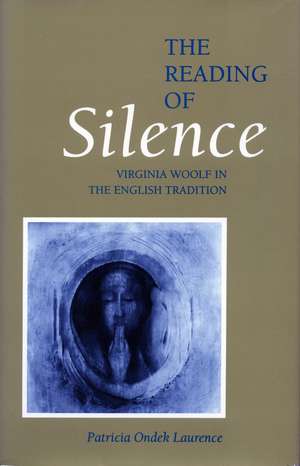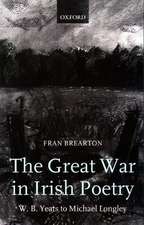The Reading of Silence: Virginia Woolf in the English Tradition
Autor Patricia Laurenceen Limba Engleză Hardback – 31 mar 1991
This is a study of Virginia Woolf's lifelong preoccupation with silence and the barrier between the sayable and the unsayable.
| Toate formatele și edițiile | Preț | Express |
|---|---|---|
| Paperback (1) | 171.22 lei 3-5 săpt. | |
| Stanford University Press – 31 iul 1993 | 171.22 lei 3-5 săpt. | |
| Hardback (1) | 647.22 lei 6-8 săpt. | |
| Stanford University Press – 31 mar 1991 | 647.22 lei 6-8 săpt. |
Preț: 647.22 lei
Preț vechi: 799.04 lei
-19% Nou
Puncte Express: 971
Preț estimativ în valută:
123.86€ • 134.49$ • 104.04£
123.86€ • 134.49$ • 104.04£
Carte tipărită la comandă
Livrare economică 23 aprilie-07 mai
Preluare comenzi: 021 569.72.76
Specificații
ISBN-13: 9780804718318
ISBN-10: 0804718318
Pagini: 256
Dimensiuni: 152 x 229 x 25 mm
Greutate: 0.54 kg
Ediția:1
Editura: Stanford University Press
Colecția Stanford University Press
ISBN-10: 0804718318
Pagini: 256
Dimensiuni: 152 x 229 x 25 mm
Greutate: 0.54 kg
Ediția:1
Editura: Stanford University Press
Colecția Stanford University Press
Recenzii
"Laurence's groundbreaking study teaches us how to read Virginia Woolf's psychological, social, historical, philosophical, rhythmic, and structural silences as it weaves multi-colored threads into a shimmering whole: Woolf's novels; the major works in Woolf criticism; the English literary tradition, male and female; surrealist painting and contemporary music; philosophy, psychoanalysis, and linguistics; and structuralism, post-structuralism, deconstruction, reader response, and feminism. It suggests new directions for Woolf criticism . . . Lawrence's writing style is remarkably readable, clear, and careful."—English Language Notes
"Using a wide range of thinkers from Kierkegaard to Kristeva and Derrida, Laurence demonstrates convincingly that Woolf was the rst modern woman novelist to practice silence in her writing and that, in so doing, she created a new language of the mind . . . and changed the metaphor of silence from one of absence or oppression to one of presence and strength."—Belles Lettres
Textul de pe ultima copertă
"Laurence's groundbreaking study teaches us how to read Virginia Woolf's psychological, social, historical, philosophical, rhythmic, and structural silences as it weaves multi-colored threads into a shimmering whole: Woolf's novels; the major works in Woolf criticism; the English literary tradition, male and female; surrealist painting and contemporary music; philosophy, psychoanalysis, and linguistics; and structuralism, post-structuralism, deconstruction, reader response, and feminism. It suggests new directions for Woolf criticism. . . . Lawrence's writing style is remarkably readable, clear, and careful."—English Language Notes
“Using a wide range of thinkers from Kierkegaard to Kristeva and Derrida, Laurence demonstrates convincingly that Woolf was the ¹rst modern woman novelist to practice silence in her writing and that, in so doing, she created a new language of the mind . . . and changed the metaphor of silence from one of absence or oppression to one of presence and strength."—Belles Lettres
“Using a wide range of thinkers from Kierkegaard to Kristeva and Derrida, Laurence demonstrates convincingly that Woolf was the ¹rst modern woman novelist to practice silence in her writing and that, in so doing, she created a new language of the mind . . . and changed the metaphor of silence from one of absence or oppression to one of presence and strength."—Belles Lettres














